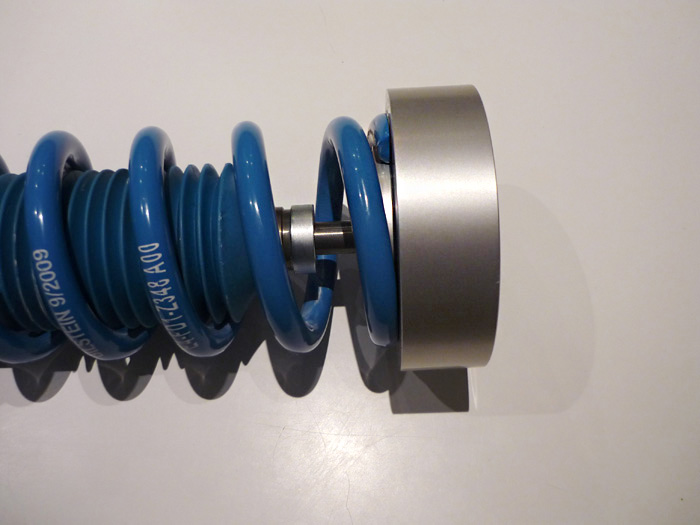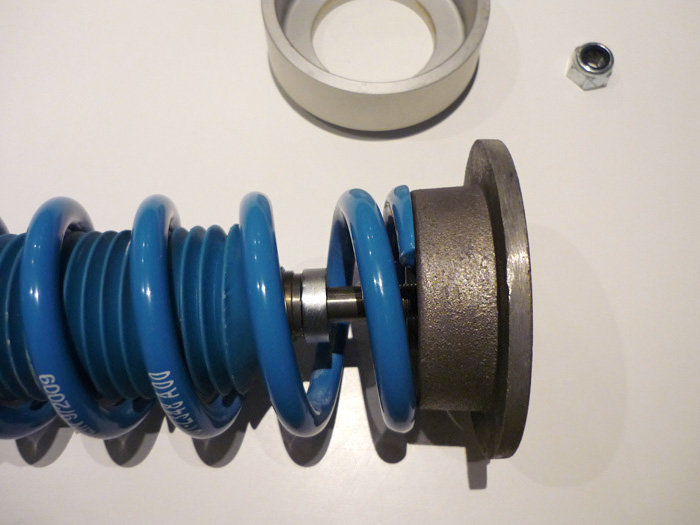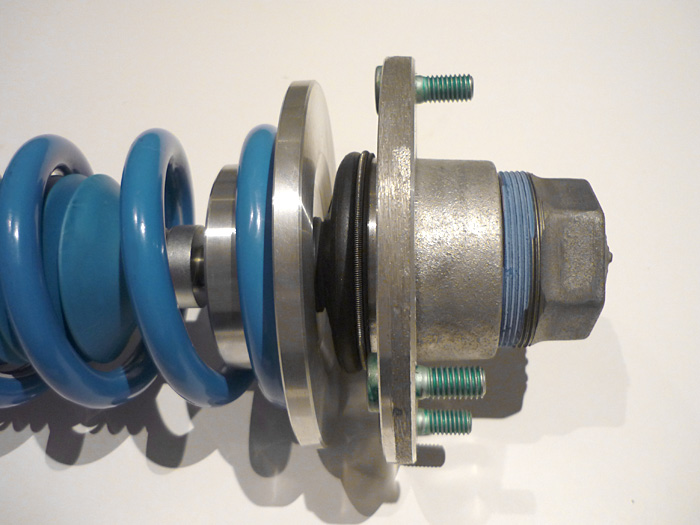Track suspension set up ?
#77
the front shock mounts will probably be designed for a 14mm shaft w/ an M14x1.5 nut the rears for a 12mm shaft w/ an M12x1.5 nut,
the spring purchases are below the shock mount and are separate items
993RS front the silver pieces on the left end are the mono-ball shock mount/camber plate. The black conical piece is the upper spring perch

similarly this is a rear 993RS shock, where the shock mount can be seen separately from the spring perch

#78
I got the idea it would fit after reading this post and jackals website. Seemed accurately described.
just an update for anyone searching teh archives
if you are fitting RS top mounts with PSS10 then you do NOT need the part number 8 in the top diagram
the rear springs do NOT fit inside the RS top mount top hat as they are are a different diameter to porsche springs
I am not certain what other people did on this thread but you have to make a new top hat that will mate properly with the top mounts but also fit properly inside the bilstein spring. I imagine the same problem will surface with other coilovers as well so be on your guard if you are ordering RS top mounts for anything other than porsche springs.

rear bilstein PSS10 with its correct top hat

rear bilstein PSS10 with ill fitting 993RS top hat

RS, Bilstein, Mine

Newly fabricated custom top hat to work with RS top mounts. I had these made as exact replicas of the RS mounts pretty much but with the correct fitting collar for the spring.

Voila
if you are fitting RS top mounts with PSS10 then you do NOT need the part number 8 in the top diagram
the rear springs do NOT fit inside the RS top mount top hat as they are are a different diameter to porsche springs
I am not certain what other people did on this thread but you have to make a new top hat that will mate properly with the top mounts but also fit properly inside the bilstein spring. I imagine the same problem will surface with other coilovers as well so be on your guard if you are ordering RS top mounts for anything other than porsche springs.
rear bilstein PSS10 with its correct top hat
rear bilstein PSS10 with ill fitting 993RS top hat
RS, Bilstein, Mine
Newly fabricated custom top hat to work with RS top mounts. I had these made as exact replicas of the RS mounts pretty much but with the correct fitting collar for the spring.
Voila
#79
These 2 pieces make up the upper spring perch
here are all the pieces bolted up, the parts from the far right to the black rubber gasket are factory RS
the 12mm nut holds it all together
#80
re: fronts, the threaded portion of the shock rod needs to be ~70mm+ long to clear the RS top mount or you'll have the same problem Mr. Jackal noted. I don't necessarily agree w/ the solution he provided as it allows ~20mm more upward wheel travel. Might be OK, but might also allow the tire to contact the fender - needs verification with your particular shocks / bumpstop arrangement!
In summary, using the RS mounts isn't trivial unless you're using RS springs & shocks as well - you might be better off asking KW which mounts are compatible with their shocks.
Bill or Cupcar - For the record, what is the ID of the 993RS springs?
BobT - have you tried various settings of rear k-toe? Curious to hear some first hand feedback of how more vs. less behaves.
Thanks-
#81
Ok so basically instead of asking if the RS top mounts will work with kw springs, I should find out whether if the top hat or perch will work with the top mounts.
the bilsteins problem being that the inner hole is way too big to work with the RS top mount on the rear ? Will check on front thread on the shocks
Kw have their own tops but after triple checking and despite what's in the catalog, not camber adjustable...
the bilsteins problem being that the inner hole is way too big to work with the RS top mount on the rear ? Will check on front thread on the shocks
Kw have their own tops but after triple checking and despite what's in the catalog, not camber adjustable...
#82
Rennlist Member
Tosi,
Kinematic toe is settled to minimal deflection on the Autometrics gauge (as close to zero as you can get it). You chase this while setting the toe and camber. I may have to mod this a bit now since most of our NE tracks are right hand turns. Instead of a balanced setup we are setting the car to turn right a bit more with some biased rebound on one side. This is very focused for racing of course. Driving and DE setups you may not want the adverse tire wear associated, but for another .5secs a lap you have to do it.
Kinematic toe is settled to minimal deflection on the Autometrics gauge (as close to zero as you can get it). You chase this while setting the toe and camber. I may have to mod this a bit now since most of our NE tracks are right hand turns. Instead of a balanced setup we are setting the car to turn right a bit more with some biased rebound on one side. This is very focused for racing of course. Driving and DE setups you may not want the adverse tire wear associated, but for another .5secs a lap you have to do it.
#83
Rennlist Member
^ To add to what Bob said, keep in mind that kinematic toe is 'dynamic', helping to influence static toe settings during suspension ROM, esp. loading/squat. It's essentially a caster adjustment and has an influence on bump steer in the rear end. IMHO if you're going to minimize kinematic toe you should have heim jointed (or at least RS stiffness bushings) control arms to reduce the impact of unintentional deflection of static alignment settings.
Last edited by jdistefa; 06-18-2012 at 02:59 AM.
#84
^ To add to what Bob said, keep in mind that kinematic toe is 'dynamic', helping to influence static toe settings during suspension ROM, esp. loading/squat. It's essentially a caster adjustment and has an influence on bump steer in the rear end. IMHO if you're going to minimize kinematic toe you should have heim jointed (or at least RS stiffness bushings) control arms to reduce the impact of unintentional deflection of static alignment settings.
On mine w/ RS Arms I set it to the min that could be obtained equally on both sides w/ the RSR/Autometrics caliper gauge
#85
Rennlist Member
Bill,
Even with solid bushings the kinematic has big effect on the rear of the car's handling. Your thinking because the factory suspension arm has one monoball already and adds deflection from the rubber bushing on the other side of the arm (which becomes solid when upgraded), but the toe is still affected from suspension travel and cornering. The 996 seems to have solved this when they changed the locations of the multi-link suspension. Porsche was certainly experimenting a bit with the 993 rear suspension (good or bad). My car is fully solid bushing and only has 1/2 an inch of suspension travel. I really feel the stability different when if the kinematic is not set properly. Again, this is track/race only and I have not driven my car on the street in 7 years.
Even with solid bushings the kinematic has big effect on the rear of the car's handling. Your thinking because the factory suspension arm has one monoball already and adds deflection from the rubber bushing on the other side of the arm (which becomes solid when upgraded), but the toe is still affected from suspension travel and cornering. The 996 seems to have solved this when they changed the locations of the multi-link suspension. Porsche was certainly experimenting a bit with the 993 rear suspension (good or bad). My car is fully solid bushing and only has 1/2 an inch of suspension travel. I really feel the stability different when if the kinematic is not set properly. Again, this is track/race only and I have not driven my car on the street in 7 years.
#87
Rennlist Member
^^^^^^^^^ Not really Steve. I think what Bill is saying is the dynamic toe element is eliminated by going to solid bushings and that answer is yes of course. Someone new to setting up the car needs to understand that when you "zero" or minimize the setting using the Autometric gauge, you have to chase the adjustment multiple times to get it right (or at least close). The newer cars make this so much easier. Porsche set the arm geometry for the 993 so that each adjustment adversely affects the other.
#88
Bill,
Even with solid bushings the kinematic has big effect on the rear of the car's handling. Your thinking because the factory suspension arm has one monoball already and adds deflection from the rubber bushing on the other side of the arm (which becomes solid when upgraded), but the toe is still affected from suspension travel and cornering. The 996 seems to have solved this when they changed the locations of the multi-link suspension. Porsche was certainly experimenting a bit with the 993 rear suspension (good or bad). My car is fully solid bushing and only has 1/2 an inch of suspension travel. I really feel the stability different when if the kinematic is not set properly. Again, this is track/race only and I have not driven my car on the street in 7 years.
Even with solid bushings the kinematic has big effect on the rear of the car's handling. Your thinking because the factory suspension arm has one monoball already and adds deflection from the rubber bushing on the other side of the arm (which becomes solid when upgraded), but the toe is still affected from suspension travel and cornering. The 996 seems to have solved this when they changed the locations of the multi-link suspension. Porsche was certainly experimenting a bit with the 993 rear suspension (good or bad). My car is fully solid bushing and only has 1/2 an inch of suspension travel. I really feel the stability different when if the kinematic is not set properly. Again, this is track/race only and I have not driven my car on the street in 7 years.
Toe always changes w/ suspension travel(it can never by eliminated w/ 2 plane suspension arm set ups) and that still happens, it will be minimized when the A-arm is parallel to the ground at static ride height and by having caster set to the minimum, more caster always means more toe change w/ suspension travel. Having mono-***** at the other rear suspension positions further reduces rear steer by eliminating any horizontal plane play, as far as I'm concerned RS bushes do any adequate job, RSR mono-***** are just better for track use.
This is from the RSR suspension setup, notice that what is the KT arm on a street car is labeled Castor?, that is because w/ all mono-***** that is all it changes, yes, changing castor also changes toe patterns but to minimize toe change(steepen the toe change curve) due to castor you minimize it.

Here is the factory explanation of how KT works, the less elastic link#5 is the less KT there is, but again toe change due to other factors is still in play


Here is a cogent explanation that Cupcar wrote(I hope that it's ok to post this)
Note the links enter the axis starting from bottom to top as track link lowest, then toe link, then kinematic (caster) link and finally on top the camber link.
The center of rotation of the suspension on this axis is behind and outside the tire patch center.
This means that during cornering the outside wheel toes in and the inside wheel toes out thus steering the car out of oversteer. During braking both rear wheels toe in or it adds to the effect during cornering.
The way it works is that the links are stacked on the axis so the greatest force is absorbed by the track arm bearing causing compression which allows rotation about the toe arm which is the next arm above the track arm on the axis thus moving the wheel into toe in or toe out depending on the side of the wheel the force is directed toward.
The magnitude of the rotation force is controlled by the amount of caster the kinematic link allows, the higher the cornering force the greater the rotation force on the wheel as the force line from rotation axis to tire center grows.
The camber arm is the upper pivot for all this and looks to be mostly in tension.
Also, in looking at the 6 of 8 rubber bushings I removed from my arms, I note that 4 of them are identical to the ones still in my track arms, but 2 of them have a metal core that is larger in diameter. This means that the rubber in these 2 bearings is thinner and thus not as deformable as the others. I bet these 2 came out of the toe arms and are designed to allow differential motion between the track arm bushing and toe arm bushing to achieve the toe in and out.
The center of rotation of the suspension on this axis is behind and outside the tire patch center.
This means that during cornering the outside wheel toes in and the inside wheel toes out thus steering the car out of oversteer. During braking both rear wheels toe in or it adds to the effect during cornering.
The way it works is that the links are stacked on the axis so the greatest force is absorbed by the track arm bearing causing compression which allows rotation about the toe arm which is the next arm above the track arm on the axis thus moving the wheel into toe in or toe out depending on the side of the wheel the force is directed toward.
The magnitude of the rotation force is controlled by the amount of caster the kinematic link allows, the higher the cornering force the greater the rotation force on the wheel as the force line from rotation axis to tire center grows.
The camber arm is the upper pivot for all this and looks to be mostly in tension.
Also, in looking at the 6 of 8 rubber bushings I removed from my arms, I note that 4 of them are identical to the ones still in my track arms, but 2 of them have a metal core that is larger in diameter. This means that the rubber in these 2 bearings is thinner and thus not as deformable as the others. I bet these 2 came out of the toe arms and are designed to allow differential motion between the track arm bushing and toe arm bushing to achieve the toe in and out.
#89
Race Car
^^^^^^^^^ Not really Steve. I think what Bill is saying is the dynamic toe element is eliminated by going to solid bushings and that answer is yes of course. Someone new to setting up the car needs to understand that when you "zero" or minimize the setting using the Autometric gauge, you have to chase the adjustment multiple times to get it right (or at least close). The newer cars make this so much easier. Porsche set the arm geometry for the 993 so that each adjustment adversely affects the other.
However, you are so right on "chasing" the adjustment to get it right. This is part of the reason shops charge so much for an alignment on these cars.
I can remember the first time I did the rear alignment, it was very frustrating, I would get everything close then go back to check and the adjustment had changed
#90
^^^^^^^^^ Not really Steve. I think what Bill is saying is the dynamic toe element is eliminated by going to solid bushings and that answer is yes of course. Someone new to setting up the car needs to understand that when you "zero" or minimize the setting using the Autometric gauge, you have to chase the adjustment multiple times to get it right (or at least close). The newer cars make this so much easier. Porsche set the arm geometry for the 993 so that each adjustment adversely affects the other.
996/997 uses 4 arms(#'s 1, 2, 3, 4)in a sort of parallel plane arrangement and then has a separate toe control arm which is not clearly labeled, there is no provision for dynamic cater change

996 rear




 time
time 